Case Study: Ethical Dilemma Analysis and EDM in the IT Industry
VerifiedAdded on 2020/02/24
|28
|6603
|177
Report
AI Summary
This report provides an in-depth analysis of an ethical dilemma faced by professionals in the technology industry. It uses the Ethical Decision Model (EDM) to explore how individuals can navigate complex situations and make virtuous decisions. The report examines various factors, including legal, professional, employment, and personal considerations, to highlight the importance of ethical conduct. It delves into a case study involving actions of different actors and discusses the role of corporate codes of conduct in guiding ethical interactions within the IT industry. The analysis includes prioritization of ethical factors and provides insights into how to avoid making wrong decisions when faced with ethical dilemmas. The report emphasizes the importance of commitment, inner consciousness, and competency in making ethical decisions, concluding with reflections on what was learned from the course.

Professional Issues Assignment Analysis
Contents
1. Introduction 2
2. Analysis 3
2.1. Legal factors..............................................................................3
2.2. Professional factors...................................................................3
2.3. Employment and Social factors.................................................3
2.4. Personal factors.........................................................................3
2.5. Intrinsic factors..........................................................................4
2.6. Prioritisation...............................................................................5
2.7. Decision.....................................................................................5
3. Discussion 7
4. Conclusions on Analysis 7
5. What I have learned from this course 7
(Student Name, Course, Semester, Year) 0 Page 1
Contents
1. Introduction 2
2. Analysis 3
2.1. Legal factors..............................................................................3
2.2. Professional factors...................................................................3
2.3. Employment and Social factors.................................................3
2.4. Personal factors.........................................................................3
2.5. Intrinsic factors..........................................................................4
2.6. Prioritisation...............................................................................5
2.7. Decision.....................................................................................5
3. Discussion 7
4. Conclusions on Analysis 7
5. What I have learned from this course 7
(Student Name, Course, Semester, Year) 0 Page 1
Paraphrase This Document
Need a fresh take? Get an instant paraphrase of this document with our AI Paraphraser
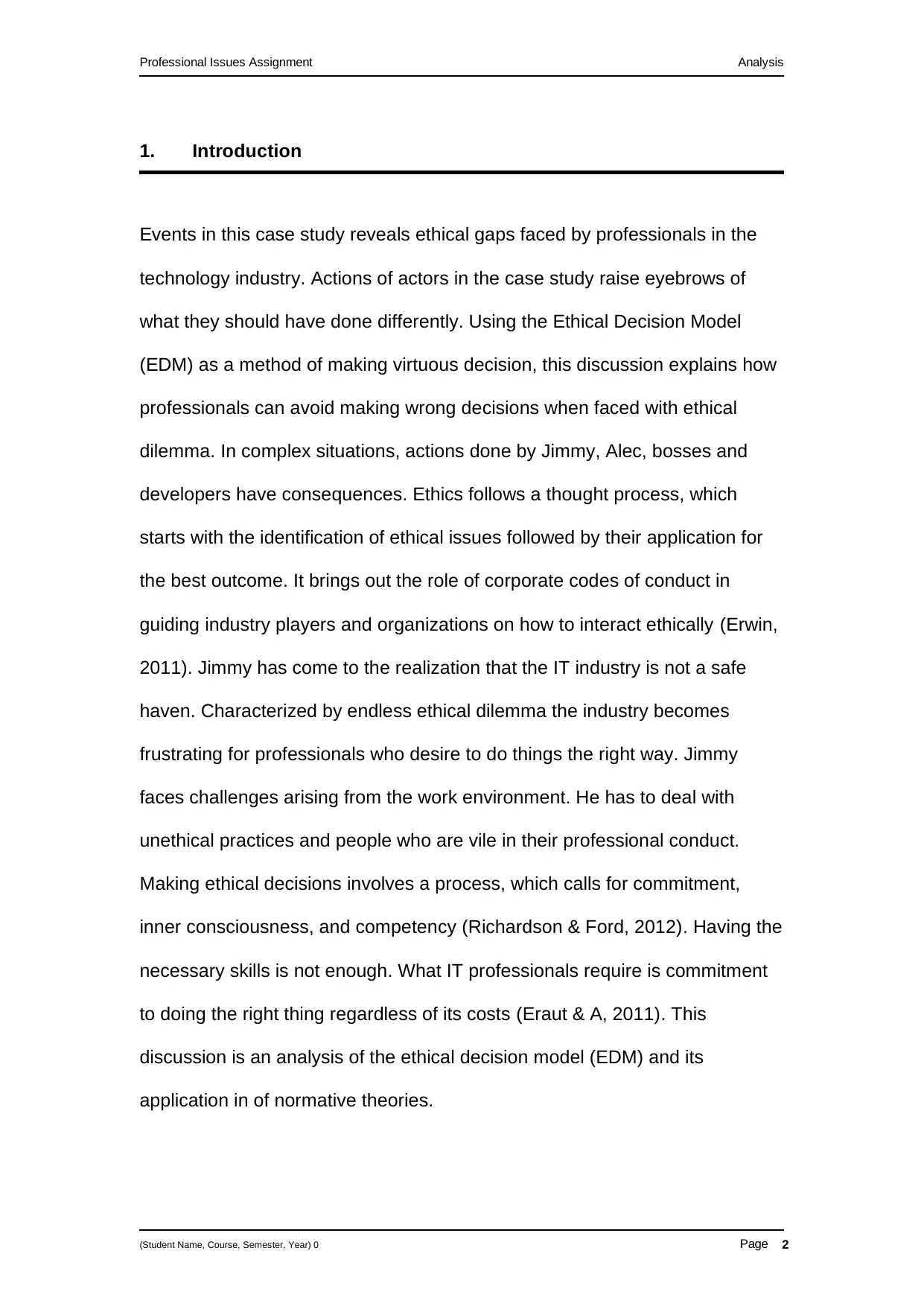
Professional Issues Assignment Analysis
1. Introduction
Events in this case study reveals ethical gaps faced by professionals in the
technology industry. Actions of actors in the case study raise eyebrows of
what they should have done differently. Using the Ethical Decision Model
(EDM) as a method of making virtuous decision, this discussion explains how
professionals can avoid making wrong decisions when faced with ethical
dilemma. In complex situations, actions done by Jimmy, Alec, bosses and
developers have consequences. Ethics follows a thought process, which
starts with the identification of ethical issues followed by their application for
the best outcome. It brings out the role of corporate codes of conduct in
guiding industry players and organizations on how to interact ethically (Erwin,
2011). Jimmy has come to the realization that the IT industry is not a safe
haven. Characterized by endless ethical dilemma the industry becomes
frustrating for professionals who desire to do things the right way. Jimmy
faces challenges arising from the work environment. He has to deal with
unethical practices and people who are vile in their professional conduct.
Making ethical decisions involves a process, which calls for commitment,
inner consciousness, and competency (Richardson & Ford, 2012). Having the
necessary skills is not enough. What IT professionals require is commitment
to doing the right thing regardless of its costs (Eraut & A, 2011). This
discussion is an analysis of the ethical decision model (EDM) and its
application in of normative theories.
(Student Name, Course, Semester, Year) 0 Page 2
1. Introduction
Events in this case study reveals ethical gaps faced by professionals in the
technology industry. Actions of actors in the case study raise eyebrows of
what they should have done differently. Using the Ethical Decision Model
(EDM) as a method of making virtuous decision, this discussion explains how
professionals can avoid making wrong decisions when faced with ethical
dilemma. In complex situations, actions done by Jimmy, Alec, bosses and
developers have consequences. Ethics follows a thought process, which
starts with the identification of ethical issues followed by their application for
the best outcome. It brings out the role of corporate codes of conduct in
guiding industry players and organizations on how to interact ethically (Erwin,
2011). Jimmy has come to the realization that the IT industry is not a safe
haven. Characterized by endless ethical dilemma the industry becomes
frustrating for professionals who desire to do things the right way. Jimmy
faces challenges arising from the work environment. He has to deal with
unethical practices and people who are vile in their professional conduct.
Making ethical decisions involves a process, which calls for commitment,
inner consciousness, and competency (Richardson & Ford, 2012). Having the
necessary skills is not enough. What IT professionals require is commitment
to doing the right thing regardless of its costs (Eraut & A, 2011). This
discussion is an analysis of the ethical decision model (EDM) and its
application in of normative theories.
(Student Name, Course, Semester, Year) 0 Page 2
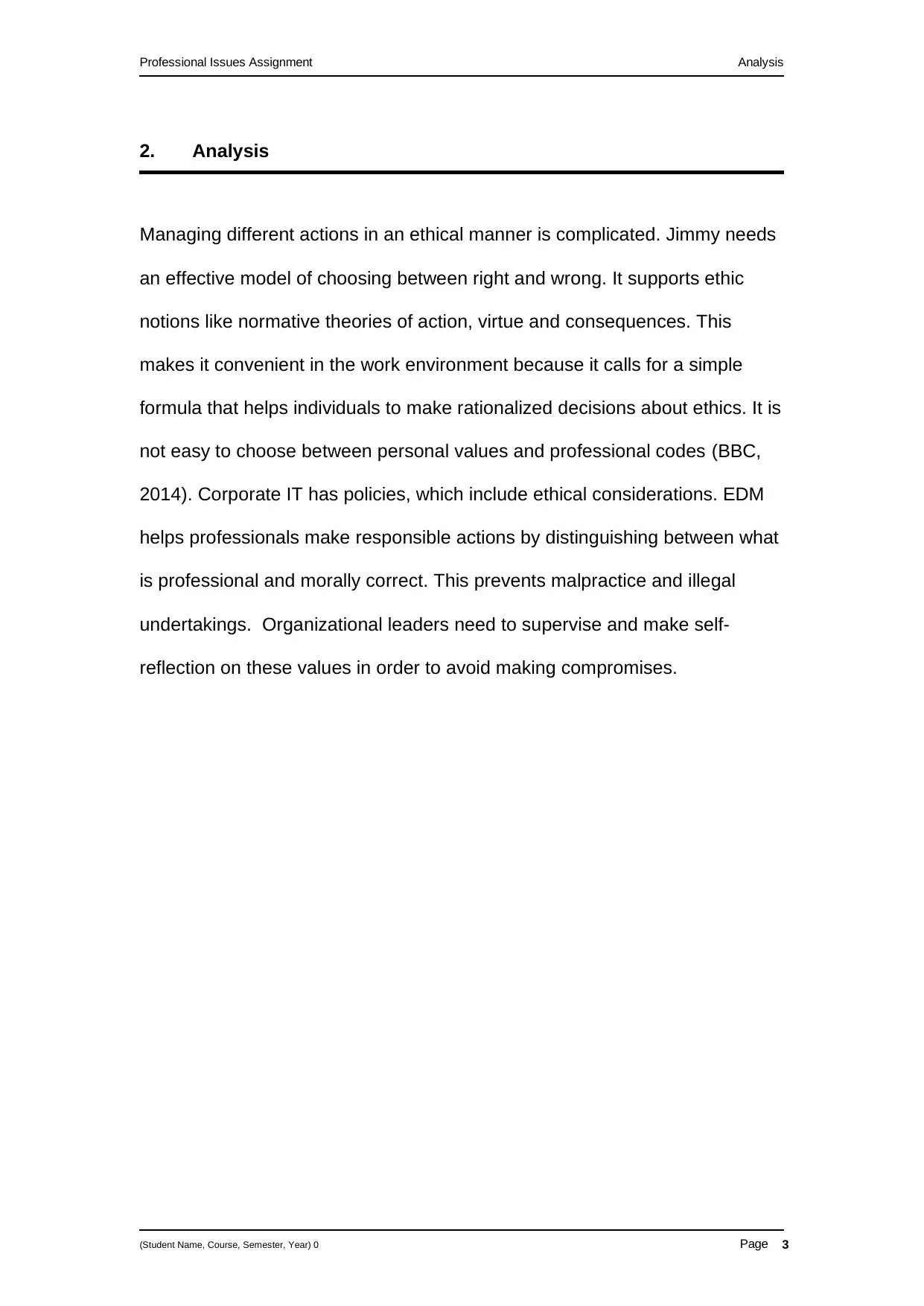
Professional Issues Assignment Analysis
2. Analysis
Managing different actions in an ethical manner is complicated. Jimmy needs
an effective model of choosing between right and wrong. It supports ethic
notions like normative theories of action, virtue and consequences. This
makes it convenient in the work environment because it calls for a simple
formula that helps individuals to make rationalized decisions about ethics. It is
not easy to choose between personal values and professional codes (BBC,
2014). Corporate IT has policies, which include ethical considerations. EDM
helps professionals make responsible actions by distinguishing between what
is professional and morally correct. This prevents malpractice and illegal
undertakings. Organizational leaders need to supervise and make self-
reflection on these values in order to avoid making compromises.
(Student Name, Course, Semester, Year) 0 Page 3
2. Analysis
Managing different actions in an ethical manner is complicated. Jimmy needs
an effective model of choosing between right and wrong. It supports ethic
notions like normative theories of action, virtue and consequences. This
makes it convenient in the work environment because it calls for a simple
formula that helps individuals to make rationalized decisions about ethics. It is
not easy to choose between personal values and professional codes (BBC,
2014). Corporate IT has policies, which include ethical considerations. EDM
helps professionals make responsible actions by distinguishing between what
is professional and morally correct. This prevents malpractice and illegal
undertakings. Organizational leaders need to supervise and make self-
reflection on these values in order to avoid making compromises.
(Student Name, Course, Semester, Year) 0 Page 3
⊘ This is a preview!⊘
Do you want full access?
Subscribe today to unlock all pages.

Trusted by 1+ million students worldwide
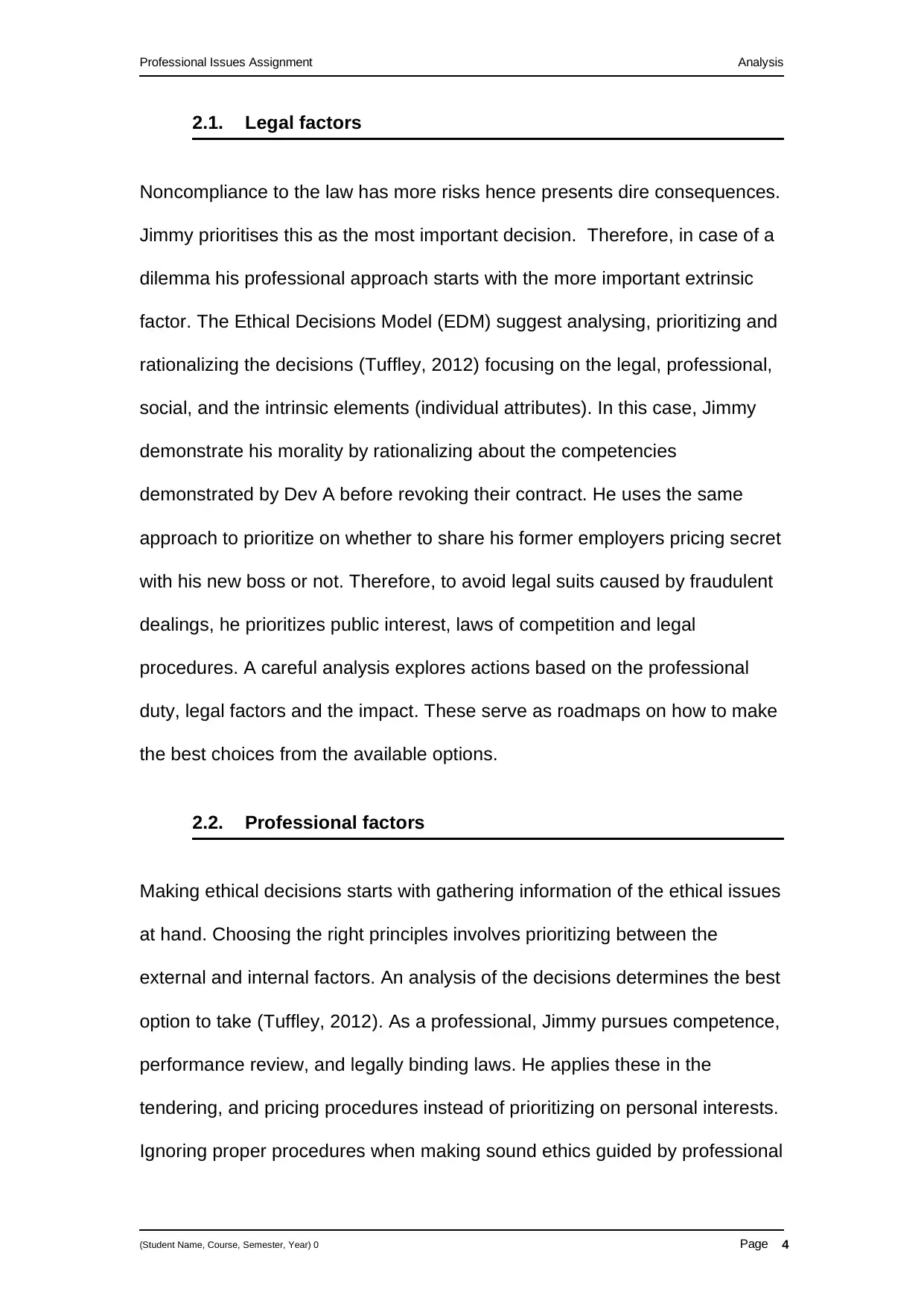
Professional Issues Assignment Analysis
2.1. Legal factors
Noncompliance to the law has more risks hence presents dire consequences.
Jimmy prioritises this as the most important decision. Therefore, in case of a
dilemma his professional approach starts with the more important extrinsic
factor. The Ethical Decisions Model (EDM) suggest analysing, prioritizing and
rationalizing the decisions (Tuffley, 2012) focusing on the legal, professional,
social, and the intrinsic elements (individual attributes). In this case, Jimmy
demonstrate his morality by rationalizing about the competencies
demonstrated by Dev A before revoking their contract. He uses the same
approach to prioritize on whether to share his former employers pricing secret
with his new boss or not. Therefore, to avoid legal suits caused by fraudulent
dealings, he prioritizes public interest, laws of competition and legal
procedures. A careful analysis explores actions based on the professional
duty, legal factors and the impact. These serve as roadmaps on how to make
the best choices from the available options.
2.2. Professional factors
Making ethical decisions starts with gathering information of the ethical issues
at hand. Choosing the right principles involves prioritizing between the
external and internal factors. An analysis of the decisions determines the best
option to take (Tuffley, 2012). As a professional, Jimmy pursues competence,
performance review, and legally binding laws. He applies these in the
tendering, and pricing procedures instead of prioritizing on personal interests.
Ignoring proper procedures when making sound ethics guided by professional
(Student Name, Course, Semester, Year) 0 Page 4
2.1. Legal factors
Noncompliance to the law has more risks hence presents dire consequences.
Jimmy prioritises this as the most important decision. Therefore, in case of a
dilemma his professional approach starts with the more important extrinsic
factor. The Ethical Decisions Model (EDM) suggest analysing, prioritizing and
rationalizing the decisions (Tuffley, 2012) focusing on the legal, professional,
social, and the intrinsic elements (individual attributes). In this case, Jimmy
demonstrate his morality by rationalizing about the competencies
demonstrated by Dev A before revoking their contract. He uses the same
approach to prioritize on whether to share his former employers pricing secret
with his new boss or not. Therefore, to avoid legal suits caused by fraudulent
dealings, he prioritizes public interest, laws of competition and legal
procedures. A careful analysis explores actions based on the professional
duty, legal factors and the impact. These serve as roadmaps on how to make
the best choices from the available options.
2.2. Professional factors
Making ethical decisions starts with gathering information of the ethical issues
at hand. Choosing the right principles involves prioritizing between the
external and internal factors. An analysis of the decisions determines the best
option to take (Tuffley, 2012). As a professional, Jimmy pursues competence,
performance review, and legally binding laws. He applies these in the
tendering, and pricing procedures instead of prioritizing on personal interests.
Ignoring proper procedures when making sound ethics guided by professional
(Student Name, Course, Semester, Year) 0 Page 4
Paraphrase This Document
Need a fresh take? Get an instant paraphrase of this document with our AI Paraphraser

Professional Issues Assignment Analysis
convictions leads to collective wrong actions in the company (Cooperrinder &
Srivastva, 2017). An analysis of Jimmy’s moral stand compared to those
around him confirms notions by traditional ethics theorists about intentions.
Alec smith quits his job without explanation showing an unethically which
does not follow legal procedures (Allen Smith, 2016). An organization, which
has ethical foundations, will uphold legalities of contract termination. Duty
ethics encourages Jimmy to do what is right regardless of what everyone
around him is doing. Right action dictates that Jimmy makes a choice to
stand out, to do right even though it weighs him down emotionally.
In the case study, leaders fail to choose what is ethical by prioritizing legal
and professional conduct in order to fulfil a moral duty and to set an example
to followers. Supported by traditional theorists Thomas Hobbes, John Locke
and Aquinas, Kant suggests making in-depth moral judgements (Stanford
encyclopedia of Philosophy, 2002). The ethical decision model advocates for
the consideration of all possible actions while considering alternatives for the
best possible option.
2.3. Employment and Social factors
Contracts run organizations and could be employment of business
agreements. These determine legalities and ideals of the organisation. A job
contract also highlights what he society or nation practices. These may differ
across the society and organizations. EDM guides on doing right in society or
in an organization through personal and external guiding principles. Jimmy’s
personal intuition forbids certain attributes, which it considers immoral, or
(Student Name, Course, Semester, Year) 0 Page 5
convictions leads to collective wrong actions in the company (Cooperrinder &
Srivastva, 2017). An analysis of Jimmy’s moral stand compared to those
around him confirms notions by traditional ethics theorists about intentions.
Alec smith quits his job without explanation showing an unethically which
does not follow legal procedures (Allen Smith, 2016). An organization, which
has ethical foundations, will uphold legalities of contract termination. Duty
ethics encourages Jimmy to do what is right regardless of what everyone
around him is doing. Right action dictates that Jimmy makes a choice to
stand out, to do right even though it weighs him down emotionally.
In the case study, leaders fail to choose what is ethical by prioritizing legal
and professional conduct in order to fulfil a moral duty and to set an example
to followers. Supported by traditional theorists Thomas Hobbes, John Locke
and Aquinas, Kant suggests making in-depth moral judgements (Stanford
encyclopedia of Philosophy, 2002). The ethical decision model advocates for
the consideration of all possible actions while considering alternatives for the
best possible option.
2.3. Employment and Social factors
Contracts run organizations and could be employment of business
agreements. These determine legalities and ideals of the organisation. A job
contract also highlights what he society or nation practices. These may differ
across the society and organizations. EDM guides on doing right in society or
in an organization through personal and external guiding principles. Jimmy’s
personal intuition forbids certain attributes, which it considers immoral, or
(Student Name, Course, Semester, Year) 0 Page 5
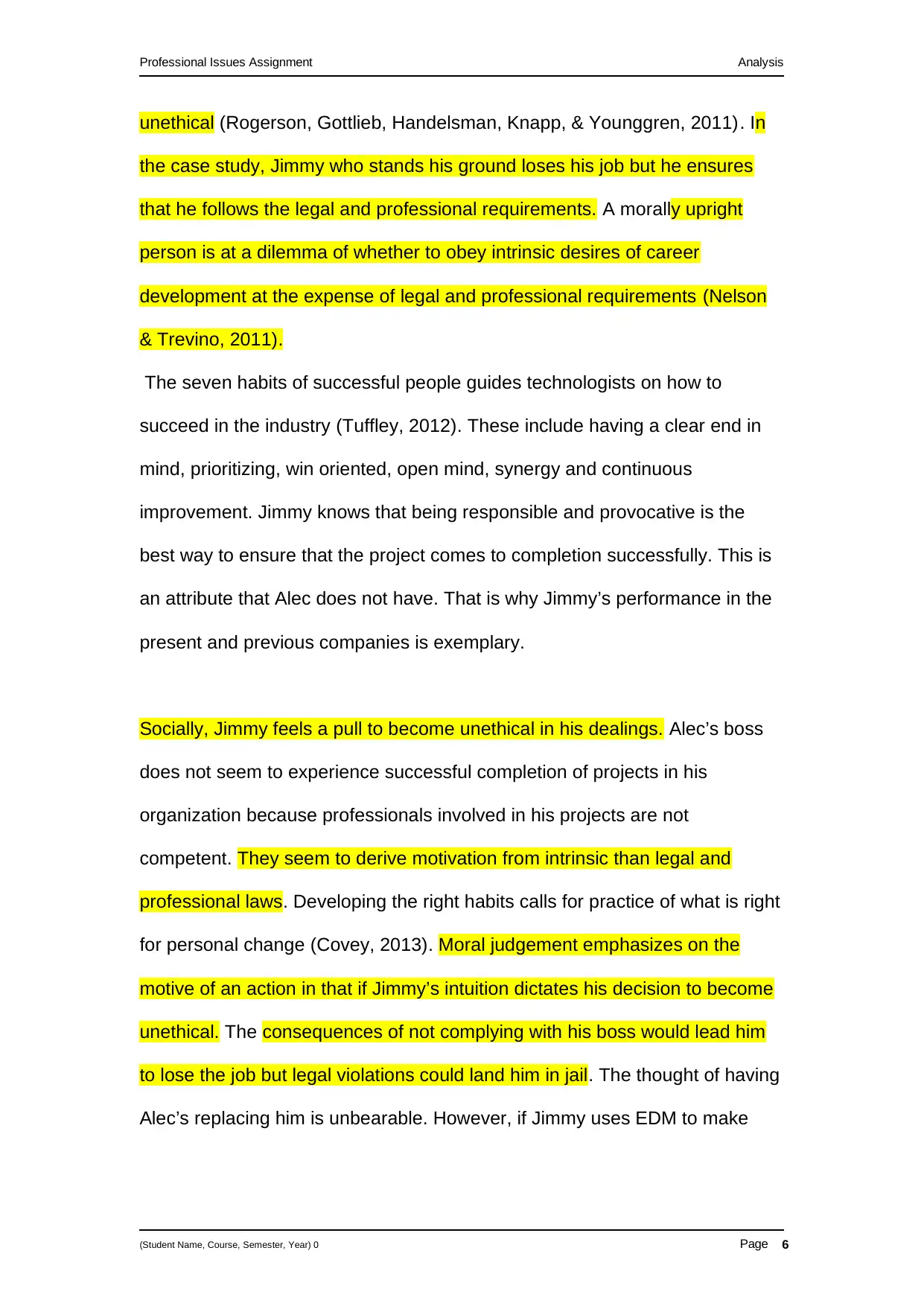
Professional Issues Assignment Analysis
unethical (Rogerson, Gottlieb, Handelsman, Knapp, & Younggren, 2011). In
the case study, Jimmy who stands his ground loses his job but he ensures
that he follows the legal and professional requirements. A morally upright
person is at a dilemma of whether to obey intrinsic desires of career
development at the expense of legal and professional requirements (Nelson
& Trevino, 2011).
The seven habits of successful people guides technologists on how to
succeed in the industry (Tuffley, 2012). These include having a clear end in
mind, prioritizing, win oriented, open mind, synergy and continuous
improvement. Jimmy knows that being responsible and provocative is the
best way to ensure that the project comes to completion successfully. This is
an attribute that Alec does not have. That is why Jimmy’s performance in the
present and previous companies is exemplary.
Socially, Jimmy feels a pull to become unethical in his dealings. Alec’s boss
does not seem to experience successful completion of projects in his
organization because professionals involved in his projects are not
competent. They seem to derive motivation from intrinsic than legal and
professional laws. Developing the right habits calls for practice of what is right
for personal change (Covey, 2013). Moral judgement emphasizes on the
motive of an action in that if Jimmy’s intuition dictates his decision to become
unethical. The consequences of not complying with his boss would lead him
to lose the job but legal violations could land him in jail. The thought of having
Alec’s replacing him is unbearable. However, if Jimmy uses EDM to make
(Student Name, Course, Semester, Year) 0 Page 6
unethical (Rogerson, Gottlieb, Handelsman, Knapp, & Younggren, 2011). In
the case study, Jimmy who stands his ground loses his job but he ensures
that he follows the legal and professional requirements. A morally upright
person is at a dilemma of whether to obey intrinsic desires of career
development at the expense of legal and professional requirements (Nelson
& Trevino, 2011).
The seven habits of successful people guides technologists on how to
succeed in the industry (Tuffley, 2012). These include having a clear end in
mind, prioritizing, win oriented, open mind, synergy and continuous
improvement. Jimmy knows that being responsible and provocative is the
best way to ensure that the project comes to completion successfully. This is
an attribute that Alec does not have. That is why Jimmy’s performance in the
present and previous companies is exemplary.
Socially, Jimmy feels a pull to become unethical in his dealings. Alec’s boss
does not seem to experience successful completion of projects in his
organization because professionals involved in his projects are not
competent. They seem to derive motivation from intrinsic than legal and
professional laws. Developing the right habits calls for practice of what is right
for personal change (Covey, 2013). Moral judgement emphasizes on the
motive of an action in that if Jimmy’s intuition dictates his decision to become
unethical. The consequences of not complying with his boss would lead him
to lose the job but legal violations could land him in jail. The thought of having
Alec’s replacing him is unbearable. However, if Jimmy uses EDM to make
(Student Name, Course, Semester, Year) 0 Page 6
⊘ This is a preview!⊘
Do you want full access?
Subscribe today to unlock all pages.

Trusted by 1+ million students worldwide
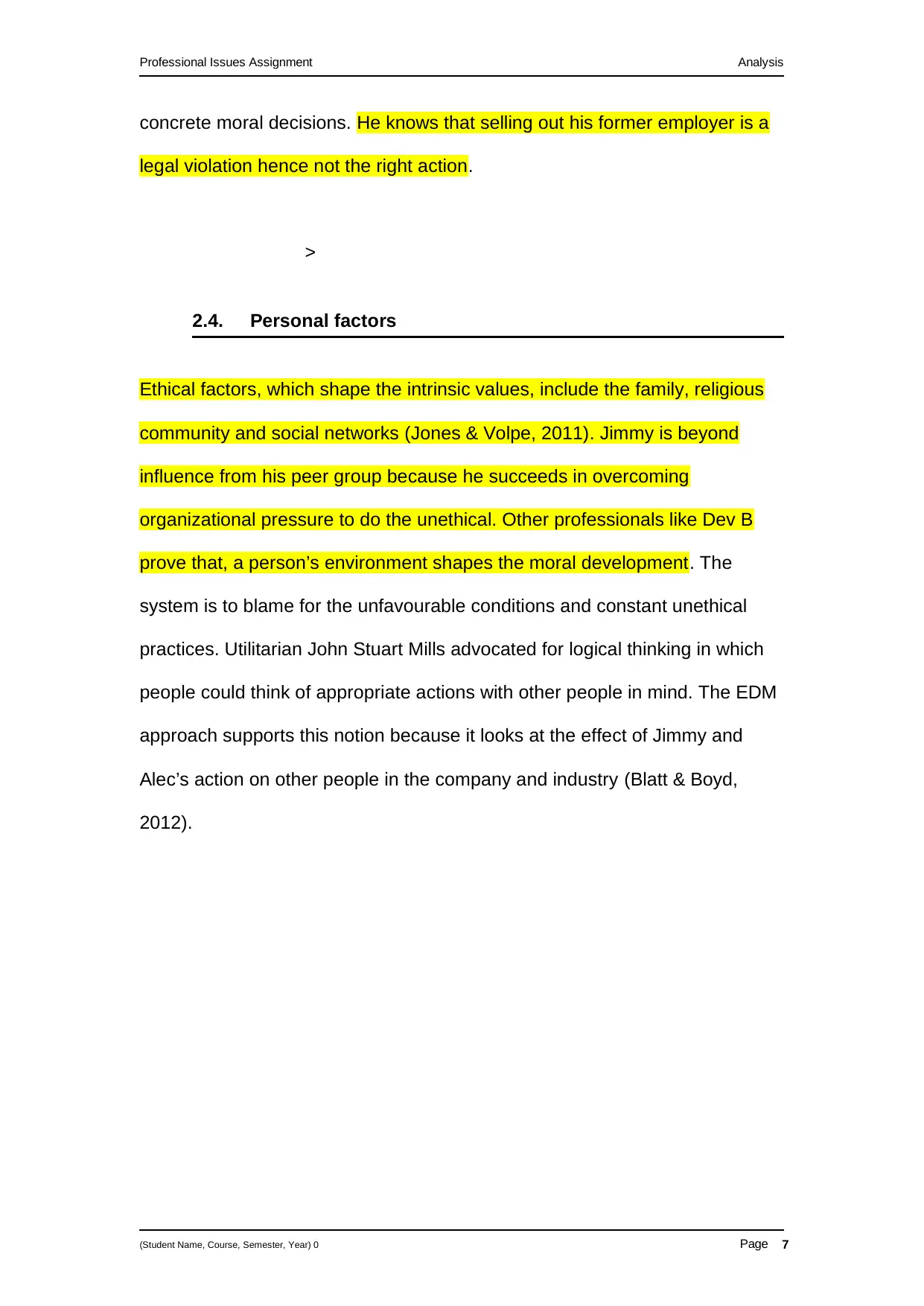
Professional Issues Assignment Analysis
concrete moral decisions. He knows that selling out his former employer is a
legal violation hence not the right action.
>
2.4. Personal factors
Ethical factors, which shape the intrinsic values, include the family, religious
community and social networks (Jones & Volpe, 2011). Jimmy is beyond
influence from his peer group because he succeeds in overcoming
organizational pressure to do the unethical. Other professionals like Dev B
prove that, a person’s environment shapes the moral development. The
system is to blame for the unfavourable conditions and constant unethical
practices. Utilitarian John Stuart Mills advocated for logical thinking in which
people could think of appropriate actions with other people in mind. The EDM
approach supports this notion because it looks at the effect of Jimmy and
Alec’s action on other people in the company and industry (Blatt & Boyd,
2012).
(Student Name, Course, Semester, Year) 0 Page 7
concrete moral decisions. He knows that selling out his former employer is a
legal violation hence not the right action.
>
2.4. Personal factors
Ethical factors, which shape the intrinsic values, include the family, religious
community and social networks (Jones & Volpe, 2011). Jimmy is beyond
influence from his peer group because he succeeds in overcoming
organizational pressure to do the unethical. Other professionals like Dev B
prove that, a person’s environment shapes the moral development. The
system is to blame for the unfavourable conditions and constant unethical
practices. Utilitarian John Stuart Mills advocated for logical thinking in which
people could think of appropriate actions with other people in mind. The EDM
approach supports this notion because it looks at the effect of Jimmy and
Alec’s action on other people in the company and industry (Blatt & Boyd,
2012).
(Student Name, Course, Semester, Year) 0 Page 7
Paraphrase This Document
Need a fresh take? Get an instant paraphrase of this document with our AI Paraphraser
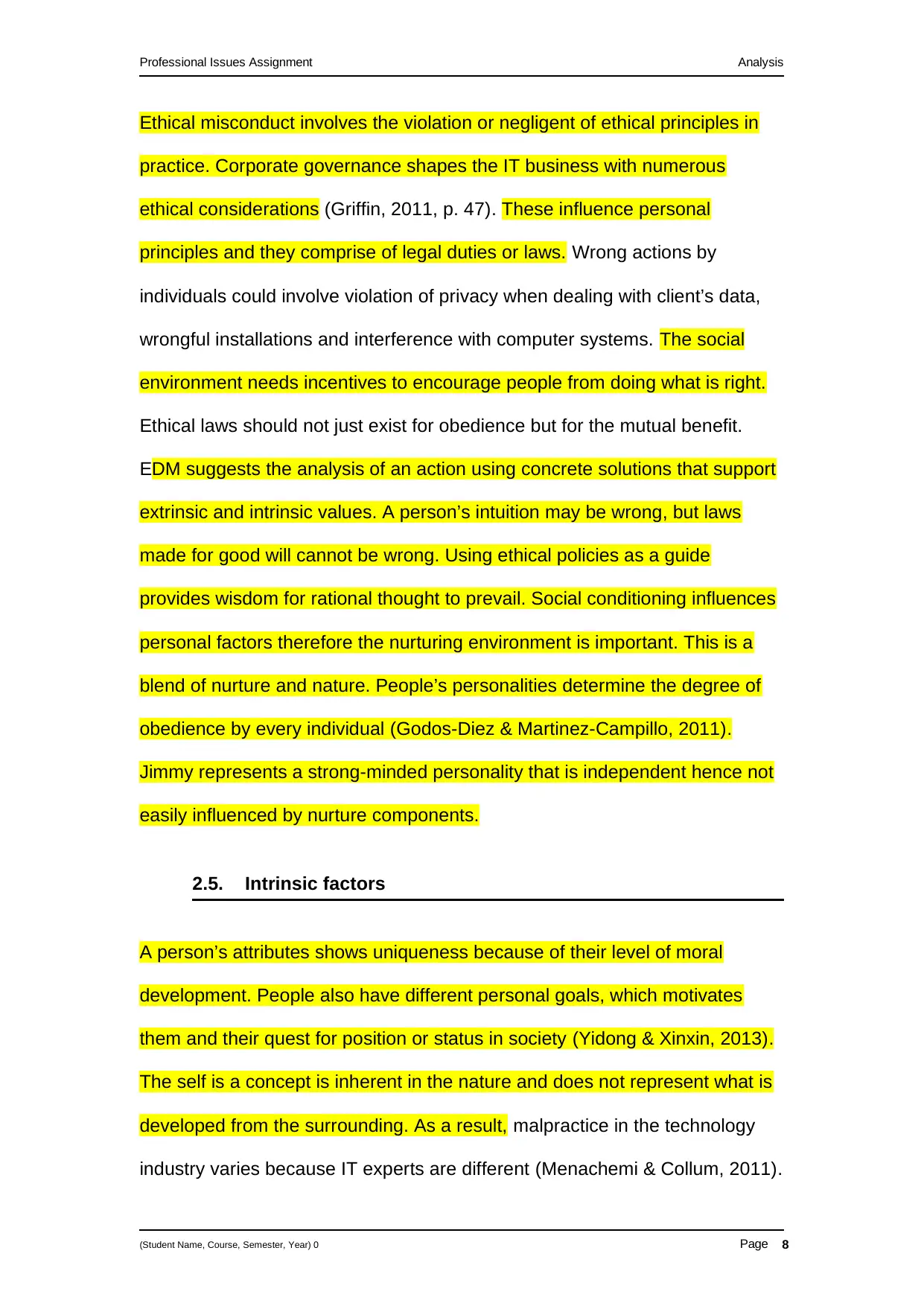
Professional Issues Assignment Analysis
Ethical misconduct involves the violation or negligent of ethical principles in
practice. Corporate governance shapes the IT business with numerous
ethical considerations (Griffin, 2011, p. 47). These influence personal
principles and they comprise of legal duties or laws. Wrong actions by
individuals could involve violation of privacy when dealing with client’s data,
wrongful installations and interference with computer systems. The social
environment needs incentives to encourage people from doing what is right.
Ethical laws should not just exist for obedience but for the mutual benefit.
EDM suggests the analysis of an action using concrete solutions that support
extrinsic and intrinsic values. A person’s intuition may be wrong, but laws
made for good will cannot be wrong. Using ethical policies as a guide
provides wisdom for rational thought to prevail. Social conditioning influences
personal factors therefore the nurturing environment is important. This is a
blend of nurture and nature. People’s personalities determine the degree of
obedience by every individual (Godos-Diez & Martinez-Campillo, 2011).
Jimmy represents a strong-minded personality that is independent hence not
easily influenced by nurture components.
2.5. Intrinsic factors
A person’s attributes shows uniqueness because of their level of moral
development. People also have different personal goals, which motivates
them and their quest for position or status in society (Yidong & Xinxin, 2013).
The self is a concept is inherent in the nature and does not represent what is
developed from the surrounding. As a result, malpractice in the technology
industry varies because IT experts are different (Menachemi & Collum, 2011).
(Student Name, Course, Semester, Year) 0 Page 8
Ethical misconduct involves the violation or negligent of ethical principles in
practice. Corporate governance shapes the IT business with numerous
ethical considerations (Griffin, 2011, p. 47). These influence personal
principles and they comprise of legal duties or laws. Wrong actions by
individuals could involve violation of privacy when dealing with client’s data,
wrongful installations and interference with computer systems. The social
environment needs incentives to encourage people from doing what is right.
Ethical laws should not just exist for obedience but for the mutual benefit.
EDM suggests the analysis of an action using concrete solutions that support
extrinsic and intrinsic values. A person’s intuition may be wrong, but laws
made for good will cannot be wrong. Using ethical policies as a guide
provides wisdom for rational thought to prevail. Social conditioning influences
personal factors therefore the nurturing environment is important. This is a
blend of nurture and nature. People’s personalities determine the degree of
obedience by every individual (Godos-Diez & Martinez-Campillo, 2011).
Jimmy represents a strong-minded personality that is independent hence not
easily influenced by nurture components.
2.5. Intrinsic factors
A person’s attributes shows uniqueness because of their level of moral
development. People also have different personal goals, which motivates
them and their quest for position or status in society (Yidong & Xinxin, 2013).
The self is a concept is inherent in the nature and does not represent what is
developed from the surrounding. As a result, malpractice in the technology
industry varies because IT experts are different (Menachemi & Collum, 2011).
(Student Name, Course, Semester, Year) 0 Page 8

Professional Issues Assignment Analysis
Individuals could fail to comply with the law and organizational principles
thereby violating the legal principles. Losing a competent, dedicated and
virtuous worker because of malice shows failure to apply EDM on his part as
a leader and manager.
EDM helps organizations and managers to avoid wrongful acts by
encouraging personal decisions based on stipulated policies. Without a
proper framework, even consumers tend to make irrational choices (Bray,
Johns, & Kilburn, 2011). Lack of a reference point demotivates employees
from undertaking moral judgements. Problems in decision making arise when
there is lack of willingness to do right.
(Student Name, Course, Semester, Year) 0 Page 9
Individuals could fail to comply with the law and organizational principles
thereby violating the legal principles. Losing a competent, dedicated and
virtuous worker because of malice shows failure to apply EDM on his part as
a leader and manager.
EDM helps organizations and managers to avoid wrongful acts by
encouraging personal decisions based on stipulated policies. Without a
proper framework, even consumers tend to make irrational choices (Bray,
Johns, & Kilburn, 2011). Lack of a reference point demotivates employees
from undertaking moral judgements. Problems in decision making arise when
there is lack of willingness to do right.
(Student Name, Course, Semester, Year) 0 Page 9
⊘ This is a preview!⊘
Do you want full access?
Subscribe today to unlock all pages.

Trusted by 1+ million students worldwide
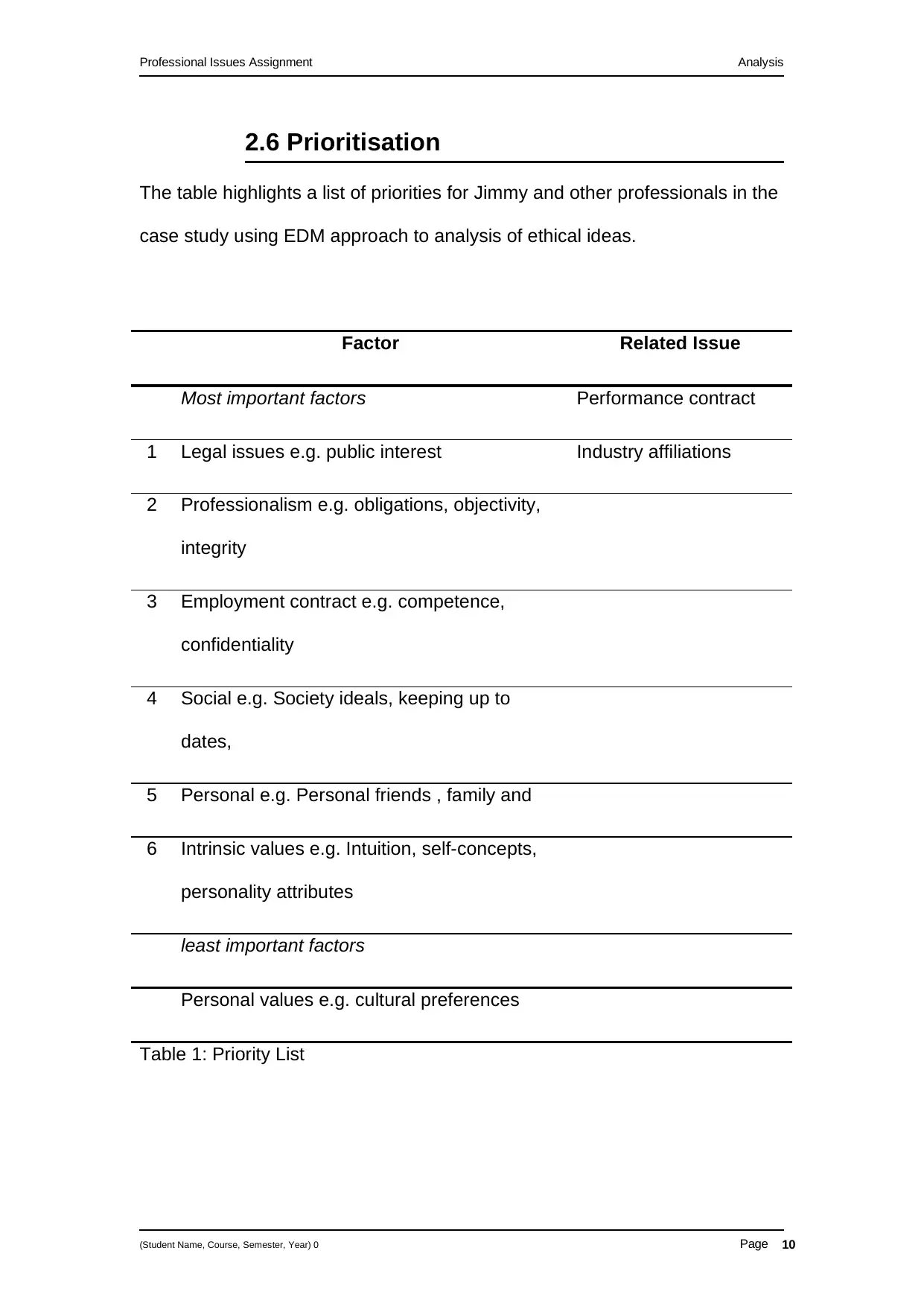
Professional Issues Assignment Analysis
2.6 Prioritisation
The table highlights a list of priorities for Jimmy and other professionals in the
case study using EDM approach to analysis of ethical ideas.
Factor Related Issue
Most important factors Performance contract
1 Legal issues e.g. public interest Industry affiliations
2 Professionalism e.g. obligations, objectivity,
integrity
3 Employment contract e.g. competence,
confidentiality
4 Social e.g. Society ideals, keeping up to
dates,
5 Personal e.g. Personal friends , family and
6 Intrinsic values e.g. Intuition, self-concepts,
personality attributes
least important factors
Personal values e.g. cultural preferences
Table 1: Priority List
(Student Name, Course, Semester, Year) 0 Page 10
2.6 Prioritisation
The table highlights a list of priorities for Jimmy and other professionals in the
case study using EDM approach to analysis of ethical ideas.
Factor Related Issue
Most important factors Performance contract
1 Legal issues e.g. public interest Industry affiliations
2 Professionalism e.g. obligations, objectivity,
integrity
3 Employment contract e.g. competence,
confidentiality
4 Social e.g. Society ideals, keeping up to
dates,
5 Personal e.g. Personal friends , family and
6 Intrinsic values e.g. Intuition, self-concepts,
personality attributes
least important factors
Personal values e.g. cultural preferences
Table 1: Priority List
(Student Name, Course, Semester, Year) 0 Page 10
Paraphrase This Document
Need a fresh take? Get an instant paraphrase of this document with our AI Paraphraser
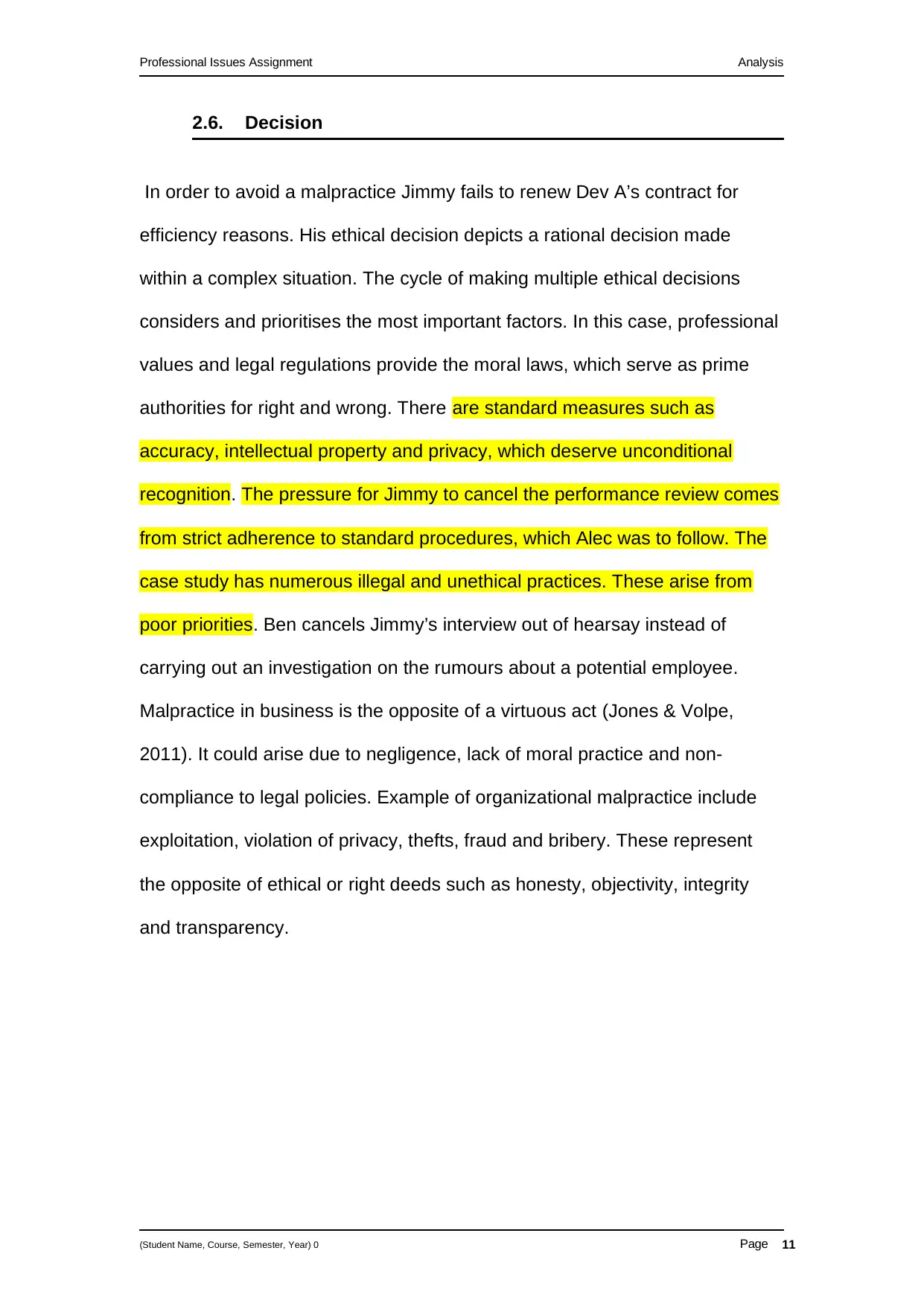
Professional Issues Assignment Analysis
2.6. Decision
In order to avoid a malpractice Jimmy fails to renew Dev A’s contract for
efficiency reasons. His ethical decision depicts a rational decision made
within a complex situation. The cycle of making multiple ethical decisions
considers and prioritises the most important factors. In this case, professional
values and legal regulations provide the moral laws, which serve as prime
authorities for right and wrong. There are standard measures such as
accuracy, intellectual property and privacy, which deserve unconditional
recognition. The pressure for Jimmy to cancel the performance review comes
from strict adherence to standard procedures, which Alec was to follow. The
case study has numerous illegal and unethical practices. These arise from
poor priorities. Ben cancels Jimmy’s interview out of hearsay instead of
carrying out an investigation on the rumours about a potential employee.
Malpractice in business is the opposite of a virtuous act (Jones & Volpe,
2011). It could arise due to negligence, lack of moral practice and non-
compliance to legal policies. Example of organizational malpractice include
exploitation, violation of privacy, thefts, fraud and bribery. These represent
the opposite of ethical or right deeds such as honesty, objectivity, integrity
and transparency.
(Student Name, Course, Semester, Year) 0 Page 11
2.6. Decision
In order to avoid a malpractice Jimmy fails to renew Dev A’s contract for
efficiency reasons. His ethical decision depicts a rational decision made
within a complex situation. The cycle of making multiple ethical decisions
considers and prioritises the most important factors. In this case, professional
values and legal regulations provide the moral laws, which serve as prime
authorities for right and wrong. There are standard measures such as
accuracy, intellectual property and privacy, which deserve unconditional
recognition. The pressure for Jimmy to cancel the performance review comes
from strict adherence to standard procedures, which Alec was to follow. The
case study has numerous illegal and unethical practices. These arise from
poor priorities. Ben cancels Jimmy’s interview out of hearsay instead of
carrying out an investigation on the rumours about a potential employee.
Malpractice in business is the opposite of a virtuous act (Jones & Volpe,
2011). It could arise due to negligence, lack of moral practice and non-
compliance to legal policies. Example of organizational malpractice include
exploitation, violation of privacy, thefts, fraud and bribery. These represent
the opposite of ethical or right deeds such as honesty, objectivity, integrity
and transparency.
(Student Name, Course, Semester, Year) 0 Page 11
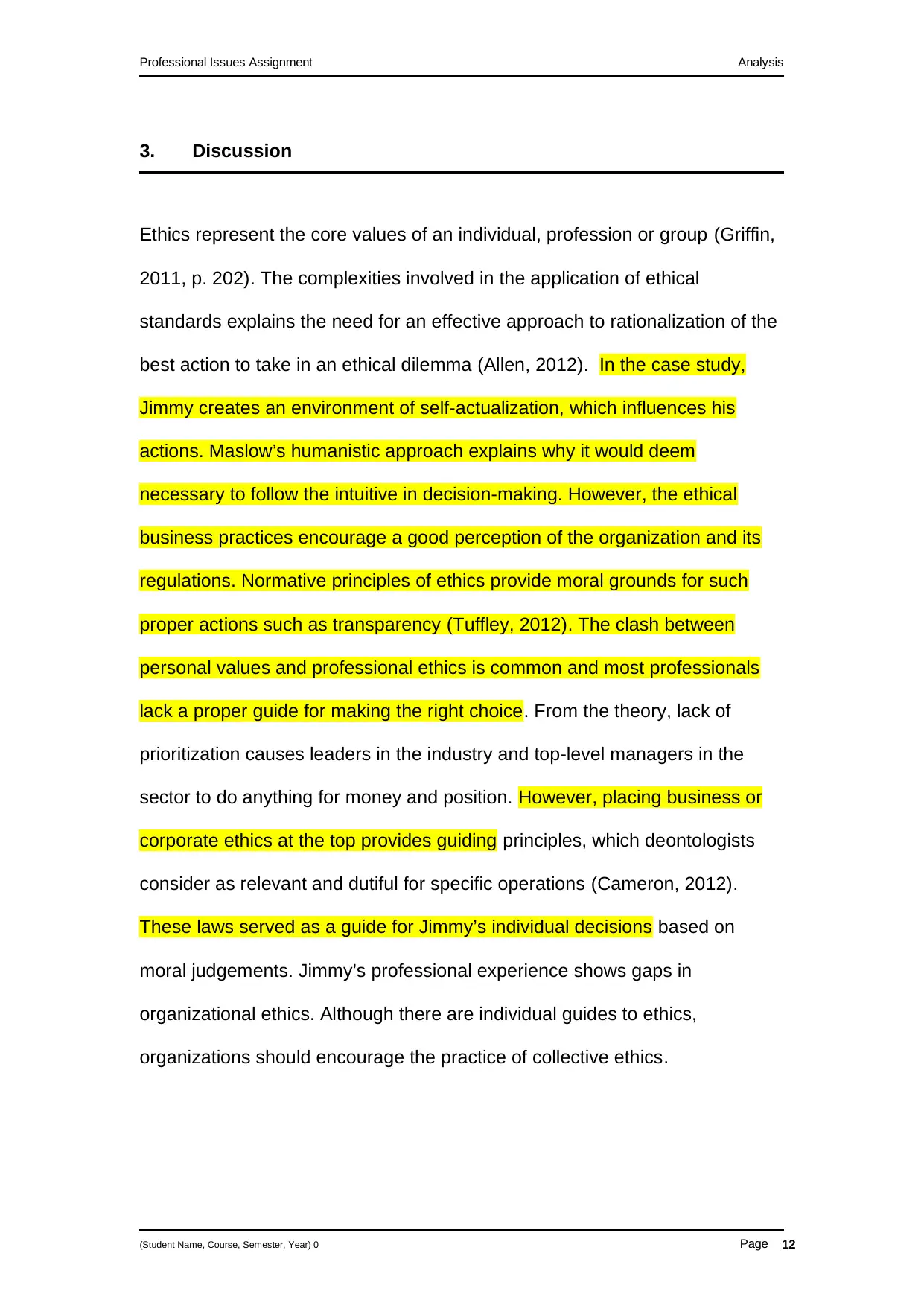
Professional Issues Assignment Analysis
3. Discussion
Ethics represent the core values of an individual, profession or group (Griffin,
2011, p. 202). The complexities involved in the application of ethical
standards explains the need for an effective approach to rationalization of the
best action to take in an ethical dilemma (Allen, 2012). In the case study,
Jimmy creates an environment of self-actualization, which influences his
actions. Maslow’s humanistic approach explains why it would deem
necessary to follow the intuitive in decision-making. However, the ethical
business practices encourage a good perception of the organization and its
regulations. Normative principles of ethics provide moral grounds for such
proper actions such as transparency (Tuffley, 2012). The clash between
personal values and professional ethics is common and most professionals
lack a proper guide for making the right choice. From the theory, lack of
prioritization causes leaders in the industry and top-level managers in the
sector to do anything for money and position. However, placing business or
corporate ethics at the top provides guiding principles, which deontologists
consider as relevant and dutiful for specific operations (Cameron, 2012).
These laws served as a guide for Jimmy’s individual decisions based on
moral judgements. Jimmy’s professional experience shows gaps in
organizational ethics. Although there are individual guides to ethics,
organizations should encourage the practice of collective ethics.
(Student Name, Course, Semester, Year) 0 Page 12
3. Discussion
Ethics represent the core values of an individual, profession or group (Griffin,
2011, p. 202). The complexities involved in the application of ethical
standards explains the need for an effective approach to rationalization of the
best action to take in an ethical dilemma (Allen, 2012). In the case study,
Jimmy creates an environment of self-actualization, which influences his
actions. Maslow’s humanistic approach explains why it would deem
necessary to follow the intuitive in decision-making. However, the ethical
business practices encourage a good perception of the organization and its
regulations. Normative principles of ethics provide moral grounds for such
proper actions such as transparency (Tuffley, 2012). The clash between
personal values and professional ethics is common and most professionals
lack a proper guide for making the right choice. From the theory, lack of
prioritization causes leaders in the industry and top-level managers in the
sector to do anything for money and position. However, placing business or
corporate ethics at the top provides guiding principles, which deontologists
consider as relevant and dutiful for specific operations (Cameron, 2012).
These laws served as a guide for Jimmy’s individual decisions based on
moral judgements. Jimmy’s professional experience shows gaps in
organizational ethics. Although there are individual guides to ethics,
organizations should encourage the practice of collective ethics.
(Student Name, Course, Semester, Year) 0 Page 12
⊘ This is a preview!⊘
Do you want full access?
Subscribe today to unlock all pages.

Trusted by 1+ million students worldwide
1 out of 28
Related Documents
Your All-in-One AI-Powered Toolkit for Academic Success.
+13062052269
info@desklib.com
Available 24*7 on WhatsApp / Email
![[object Object]](/_next/static/media/star-bottom.7253800d.svg)
Unlock your academic potential
Copyright © 2020–2025 A2Z Services. All Rights Reserved. Developed and managed by ZUCOL.





